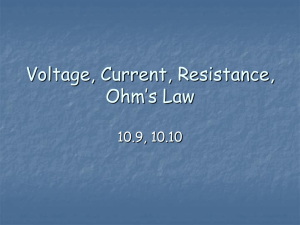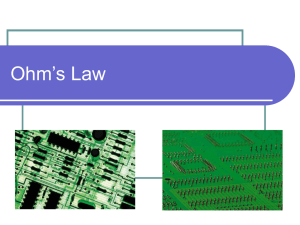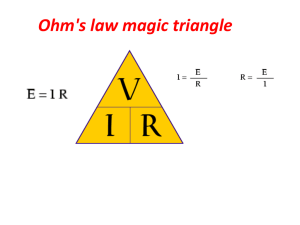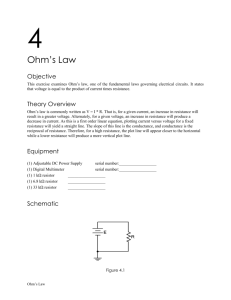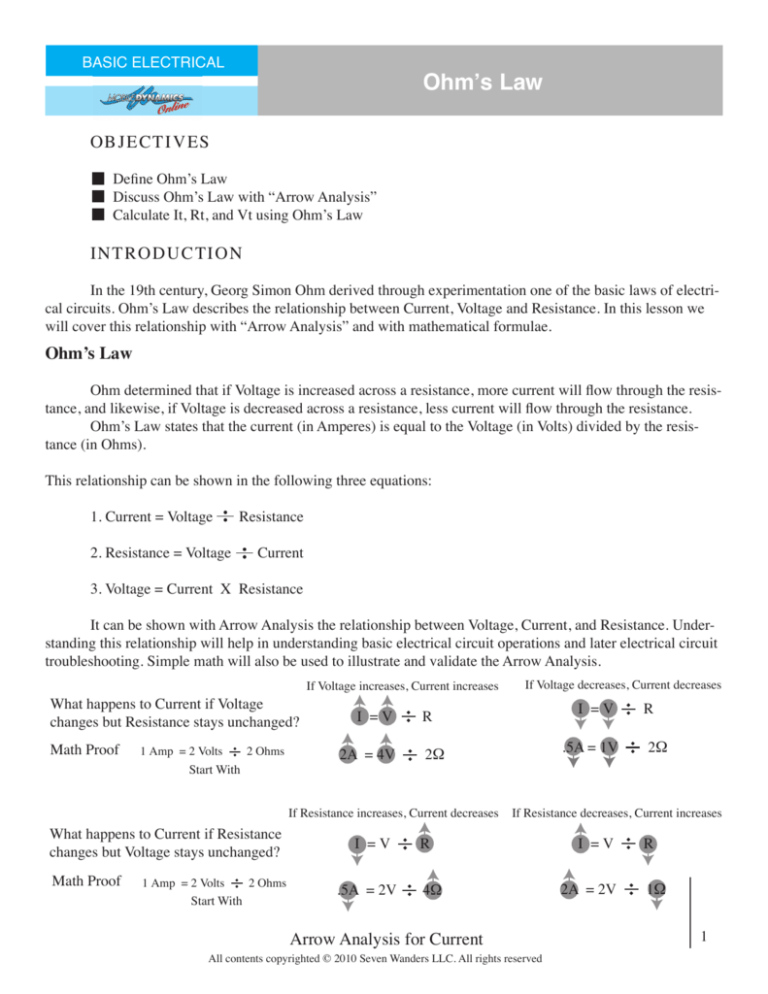
BASIC ELECTRICAL
Ohm’s Law
OBJECTIVES
Define Ohm’s Law
Discuss Ohm’s Law with “Arrow Analysis”
Calculate It, Rt, and Vt using Ohm’s Law
INTRODUCTION
In the 19th century, Georg Simon Ohm derived through experimentation one of the basic laws of electrical circuits. Ohm’s Law describes the relationship between Current, Voltage and Resistance. In this lesson we
will cover this relationship with “Arrow Analysis” and with mathematical formulae.
Ohm’s Law
Ohm determined that if Voltage is increased across a resistance, more current will flow through the resistance, and likewise, if Voltage is decreased across a resistance, less current will flow through the resistance.
Ohm’s Law states that the current (in Amperes) is equal to the Voltage (in Volts) divided by the resistance (in Ohms).
This relationship can be shown in the following three equations:
1. Current = Voltage
Resistance
2. Resistance = Voltage
Current
3. Voltage = Current X Resistance
It can be shown with Arrow Analysis the relationship between Voltage, Current, and Resistance. Understanding this relationship will help in understanding basic electrical circuit operations and later electrical circuit
troubleshooting. Simple math will also be used to illustrate and validate the Arrow Analysis.
What happens to Current if Voltage
changes but Resistance stays unchanged?
Math Proof
1 Amp = 2 Volts
Start With
2 Ohms
What happens to Current if Resistance
changes but Voltage stays unchanged?
Math Proof
1 Amp = 2 Volts
Start With
2 Ohms
If Voltage increases, Current increases
I =V
2A = 4V
.5A = 2V
I =V
R
.5A = 1V
2Ω
If Resistance increases, Current decreases
I =V
If Voltage decreases, Current decreases
2Ω
If Resistance decreases, Current increases
R
4Ω
Arrow Analysis for Current
R
All contents copyrighted © 2010 Seven Wanders LLC. All rights reserved
I =V
2A = 2V
R
1Ω
1
What happens to Voltage if Current
changes but Resistance stays unchanged?
Math Proof
1 Volts = 1 Amp X 1 Ohms
Start With
V = I
X
2V = 2A X
V =I
1 Volts = 1 Amp X 1 Ohms
Start With
If Current decreases, Voltage decreases
V= I
R
X
X
R
.5V = .5A X 1Ω
1Ω
If Resistance increases, Voltage increases
What happens to Voltage if Resistance
changes but Current stays unchanged?
Math Proof
If Current increases, Voltage increases
If Resistance decreases, Voltage decreases
V =I X R
R
.5V = 1A X .5Ω
2V = 1A X 2Ω
Arrow Analysis for Voltage
If Current increases, Resistance decreases If Current decreases, Resistance increases
What happens to Resistance if Current
changes but Voltage stays unchanged?
Math Proof
1 Ohm = 2 Volts
Start With
R=V
2 Amps
.5Ω = 2V
1 Ohm = 2 Volts
Start With
4A
If Voltage increases, Resistance increases
What happens to Resistance if Voltage
changes but Current stays unchanged?
Math Proof
R=V
I
R = V
2 Amps
2Ω = 4V
2Ω = 2V
I
1A
If Voltage decreases, Resistance decreases
I
2A
R = V
.5Ω = 1V
I
2A
Arrow Analysis for Resistance
Arrow Analysis is useful for basic Ohm’s Law understanding, but it can also be used during troubleshooting of an electrical circuit. An example of the usefulness of Arrow Analysis for troubleshooting would be
if a circuit you are working on keeps “blowing a fuse”. (A fuse is an electrical component that is used to open a
circuit and stop current from flowing if too much current flows.) By replacing the fuse and measuring the voltage before the fuse blows again you can tell if the Voltage is what is expected for the circuit. With these two
pieces of information, 1) Current increases and 2) Voltage stays the same, it is determined that resistance is decreasing. (The problem.) Now a multimeter can be used to find the reason for the lowered resistance, i.e. a short.
I =V
R
If the Voltage had increased before the fuse blow, then the resistance can be checked and if it is what is
expected for the circuit the source of the Voltage is the problem. (i.e. Power Supply, Alternator, Generator ...)
I =V
R
Notice both problems cause the same issue, an increase in Current. Understanding Ohm’s Law
and Arrow Analysis can help lead you to the true reason for the failure.
All contents copyrighted © 2010 Seven Wanders LLC. All rights reserved
2
Should someone memorize Arrow Analysis? This is up to the person taking this course. But, knowing
that it exists and can be looked up when needed is important. Experience troubleshooting will help in learning
Arrow Analysis. When in doubt doing the math for the equations of Ohm’s Law will give you the Arrow Analysis charts above.
Ohm’s Law Chart
Remembering the three equations stated on the first page of this lesson, they can be made easier to
remember with a simple chart. (See Figure 1) With this chart simply cover the electrical property you want to
calculate for and what is left is the equation for the covered property.
Remember:
�
� �
Voltage is symbolized by V or E
Current is symbolized by A or I
Resistance is symbolized by R or Ω
It is hard to pick just one symbol for any electrical property
because all are used with equal regularity in electronic text
books. But I tend to use V for Voltage, I for Current, and R
for Resistance in equations. But label circuit values with V
for Voltage, A for Current, and Ω for resistance. I will use E
very rarely.
Figure 1
�
� �
Finding the Equation for Voltage using the Ohm’s Law chart
To find the equation for Voltage, place your finger over the V on the chart and you will have I R together
left. Remember back to your High School Math classes, Two variables placed together get multiplied together
and can be rewritten as I X R. So, by covering up the V you get the equation V = I X R. (See Figure 2)
�
� �
Figure 2
Finding the Equation for Current using the Ohm’s Law chart
To find the equation for Current, place your finger over the I on the chart and you will have a V above
an R separated by a line, this represents a fraction or a division equation. So, by covering up the I you get the
equation I = V R. (See Figure 3)
�
� �
Figure 3
All contents copyrighted © 2010 Seven Wanders LLC. All rights reserved
3
Finding the Equation for Resistance using the Ohm’s Law chart
To find the equation for Resistance, place your finger over the R on the chart and you will have a V
above an I separated by a line, this represents a fraction or a division equation. So, by covering up the R you get
the equation R = V I. (See Figure 4)
�
� �
Figure 4
Calculating with Ohm’s Law Equations
When calculating using Ohm’s Law equations it is important to insure that you use common terms, such
as Resistance Total (Rt), Voltage Total (Vt), or Current Total (It). In later lessons, single electrical components
can use Ohm’s Law, such as Voltage across Resistor 1 (VR1), Current through Resistor 1 (IR1), or the Resistance
of Resistor 1 (R1).
Ohm’s Law equations FAIL if you mix terms, such as Vt = Ir1 X R3. So be careful.
Practice Problems:
1.
2.
Vt = 12 V
Vt = 12 V
R1 = 6Ω
It =
Rt =
It = 6A
If there is only one resistor you can think of that as Rt.
R1 = 2Ω
3.
4.
Vt = 12 V
R1 = 2Ω
R3 = 4Ω
R2 = 5Ω
Vt =
R2 = 4Ω
It = 10 A
R3 = 3Ω
It =
Remember how to calculate Rt?
All contents copyrighted © 2010 Seven Wanders LLC. All rights reserved
4



